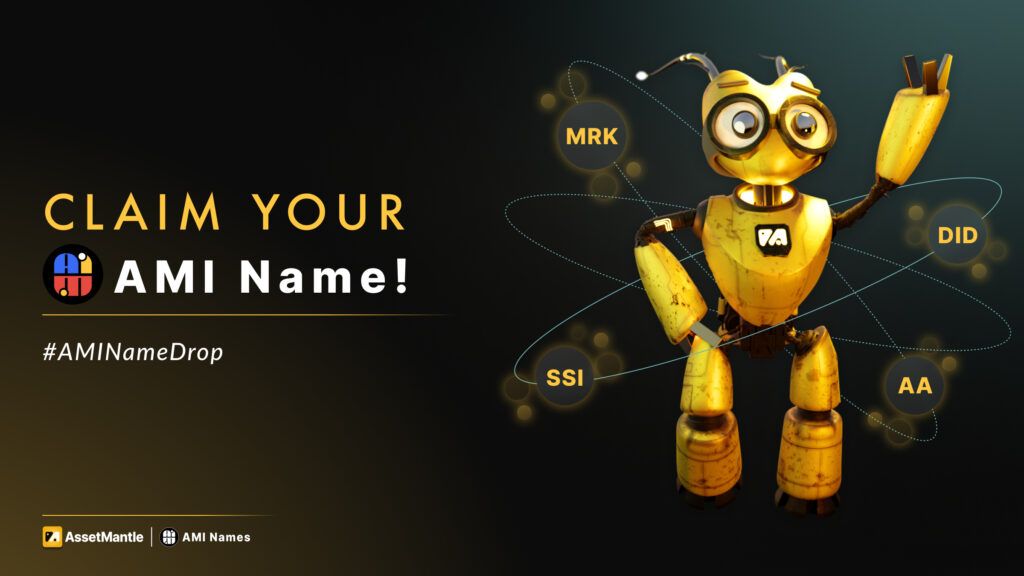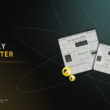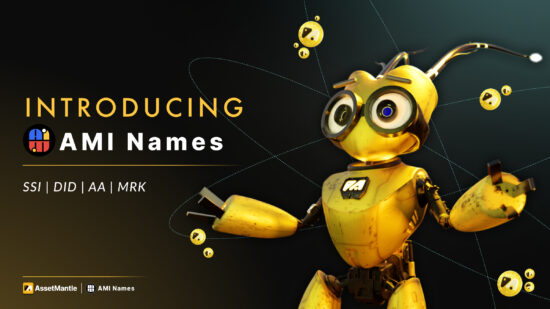Introducing AMI Names
In the ever-evolving landscape of digital identities and web3 technologies, there’s a new kid on the block – the AMI Name (pronounced AM-EYE-Name)
But what exactly is it?
AMI (AssetMantle Identity) Names is Cosmos’ first Self Sovereign Identity (SSI) which will be permanently allocated to you and will never expire, unlike other naming services in web3 and web2 ecosystems like ENS, DNS etc.
🌊Technical Deep Dive 🔎
Since it implements account abstraction (AA), a popularly evolving feature in every web3 ecosystem, your AMI Names (i.e your identity) will not be hardcoded to a single wallet address, but to a separate abstraction called Digitally Controlled Identity (DCI). But if this is quite a mouthful to mention, just call it account. This account can be controlled by one or more wallet addresses which act as ‘Provision Addresses’ or ‘Multiple Rotatable Keys’ to the account.
Hence one can choose to add or remove any number of wallet address as keys to this account, so that in case you lose the Mnemonic / Passphrase / Private Key / Password of one of the provision addresses, you could use another existing provision address to remove it and add other provision addresses. This makes sure your account stays safe and never gets accidentally ‘locked out’, as long as you have connected more than one wallet addresses as provision addresses.
AMI Names is also based on DID Specification (Decentralized Identifiers), another evolving highlight of the web3 ecosystem, which means AMI names will be resolvable as a DID Document. This means every AMI name will have a global identifier, which makes it accessible, and verifiable, anywhere across the globe from web3 or web2 ecosystem. Think of it like how URLs work in a browser but DID is a decentralized version of URLs. The “URL” of your AMI Names will resolve back to a document (DID Document) illustrating details of your identity, in a verifiable way. This resolution happens in a decentralized way, which means the resolution and verification system can never go down or be compromised. This sets the foundation of giving a “Global ID” to every identity of every actor / stakeholder, making actors/stakeholders identifiable, accessible and verifiable, from anywhere, and not just in your own local chain ecosystem.
Your AMI Name will be your one singular, lifelong web3 identity you will ever need to store and manage all your assets. It will never expire, never have downtime, can always be identified and verified from anywhere in the globe, and any ecosystem (web3 or web2), and will be always safely recoverable in case you lose one or more of the keys. The future of web3 identity is here.


Features
Unlike traditional naming systems like DNS (Domain Name System) or ENS (Ethereum Name Service), AMI Names are unique in several ways:
1. Self-Sovereign Identity (SSI): With AMI Names, you are the master of your own identity. No more seeking permission or relying on third parties to manage your digital presence – self generating, self-resolvable and multiple keys (address) linkage (MRK).
2. Permanently Allocated: Once you claim an AMI Name on mantleChain, it’s yours forever, unless you choose to voluntarily transfer control. Unlike other naming systems that allocate names temporarily, AMI-Names grant you true perpetual control over your identity, serving as an eternal digital anchorage.
3. Decentralized Identity (DID) Based: AMI Names are globally accessible & resolvable through Decentralized Identifiers (DIDs). This pioneering Web3 technology ensures your identity is decentralized and verifiable from anywhere on the globe across blockchain-ecosystems, eliminating downtime & architectural code barriers.
4. Account Abstraction (AA): Say goodbye to the fear of being locked out of your identity. AMI Names implement account abstraction, allowing you to use multiple ‘provision addresses’ as keys to maintain control. Over your single point of truth identity as a wallet.
How Do I claim my AMI Name?
User Journey for Claiming an AMIName on AssetMantle:
1. 🌐 Proceed through the referral code-link available on AssetMantle Socials or other Mantler’s or your friends
2. 💙 On the AMI Names landing page, click on the ‘Claim your own AMIName’ blue button


3. 👤 AMI Names selection page: Type in your preferred AMI Names (only lowercase). If the feedback shows ‘Available’, you will be prompted to connect your interchain web wallet extension (e.g., Keplr, Frontier, Leap Wallet, Cosmostation, or Vectis)
a. If the AMI Name is ‘Available’, proceed to step 4
b. If the AMI Name is ‘Registered’, try a different word-soup to lay claim your AMIName

4. 🔒 Validate wallet connection with a password
a. Create a connection with AssetMantle (mantleChain)
b. Pay the AMI Names nominal amount of 0.3 $MNTL
c. Approve the Transaction via your linked-wallet

5. ✅ You will see a success message indicating that you have claimed your AMI Name successfully

a. Receive a referral code with your footprint to be shared with your friends and the Mantler community
b. Use the direct share option (referral link) to popular social media platforms
Note: You can now start trading NFTs on MantlePlace using your AMINames. Additionally, AssetMantle supports chain-agnostic functionality through Multiple Rotatable Keys. Other utilities that are chain agnostic to follow soon.

Mini-FAQ
Where all can I currently use my AMI Name?
AMI Name is the only singular identity you will ever require managing the ownership of any and every kind of assets. You could in the future, use your AMI Name to login to MantlePlace Web3 (coming soon), which is AssetMantle’s upcoming fully non-custodial secondary marketplace for NFT based Assets. You could also in the future, use this identity in any Decentralized Identifier (DID) based Self Sovereign Identity (SSI) protocol, and manage ownership of assets or perform any kind of transfer of value there.
What is SSI?
SSI (Self Sovereign Identity) is a model for managing digital identities in which individuals or businesses have sole control over their accounts and personal data. Individuals with self-sovereign identity can store their data on their devices and provide it for verification and transactions without the need to rely upon a central repository of data. With self-sovereign identity, users have complete control over how they create their identity, and how their personal information is kept and used.
What is DID?
Decentralized identifiers (DIDs) are a new type of identifier that enables verifiable, decentralized digital identity. A DID refers to any subject (e.g., a person, organization, thing, data model, abstract entity, etc.) as determined by the controller of the DID. In contrast to typical, federated identifiers, DIDs have been designed so that they may be decoupled from centralized registries, identity providers, and certificate authorities. DIDs are globally unique, and resolvable as a DID Document, which means one can access and verify their identity from anywhere, with no ‘down time’
What is Account Abstraction?
Account Abstraction refers to de-coupling the association of your account from a single ‘blockchain address’, and making it an independently existing entity, where one can allocate multiple “blockchain address’ based keys to operate the account. This dissociates from the idea of ‘account’ that exists in blockchains like Ethereum, where “blockchain address” IS the account itself, and makes it into a separate entity, where “blockchain addresses” can be added / removed as ‘provision keys’. Account abstraction is now getting popular in Ethereum as well, by introduction of ERC-4337, a standard for Account Abstraction.
What is a Provision Address/Provision Address Key?
Provision address is your blockchain address that you use as the ‘key’ to operate your Account. This address will be used to create transactions that can transfer assets to and from your account or perform other operations. You can allocate multiple provision addresses to your account, adding an extra layer of security to your single source of truth (SSI). If you lose the private key of one provision address, you can use another to replace the compromised one, preventing any loss of control. This de-couples the account from being allocated to a single blockchain address, controlled by a single private key.
What are Multiple Rotatable Keys (MRK)
Multiple Rotatable Keys (MRK) is a concept of Account abstraction where multiple provision addresses can be allocated to an account as ‘keys’ which control the account. These keys can then be ‘rotated’ in and out of operation. One can rotate out their keys in regular intervals so as to provide extra security in case a key gets compromised. This is similar to changing your passwords regularly as a best practice for security, in web2.
For how long do I own the AMI-Name?
Your AMI-Name is yours for life unless you choose to transfer control to someone else. It’s a perpetual asset that grants you full control over your digital identity.
How do I Transfer my AMI Names?
AMI Name is conceptually supposed to be a singular allocation for each user / organization / institution etc. But still, in case you want to transfer your AMI Name, you will have to use one of your connected provision addresses to your AMI Name, to add an additional provision address which belongs to the recipient. You will also have to de-provision every other connected provision address, leaving the newly added provision address as the sole provision address. The recipient will then have exclusive control over the AMI Name, and will have to, as best practice, add more provision addresses as keys for account recovery.

About AssetMantle
AssetMantle is a multi-tenant NFT marketplace framework that enables creators and collectors to securely mint, own, and trade digital assets on its fast-finality blockchain. The AssetMantle no-code toolset allows creators to create customized assets and marketplaces permissionless-ly . Likewise, collectors can own the assets minted across these marketplaces and compatible chains in a singular wallet with minimal gas and a lower carbon footprint. Built on the interNFT standard, AssetMantle implements an end-to-end stack of open-source modular tools that developers can modify to fit advanced use cases.
contribute to interchain NFT standards; currently being spearheaded by us & the interchain foundation: https://github.com/interNFT/nft-rfc/tree/main
Vision
Build an open-source, community-driven framework for inter-chain NFTs and metadata standardization by contributing to the ‘interNFT standard’.
Mission
Provide a platform that enables a diverse set of NFTs use cases that extend beyond arts and collectibles and can potentially change the representation of rights and ownership of real-world assets like real estate and other commodities.

AssetMantle is always on the lookout to connect with individuals or organizations who wish to take advantage of the opportunities present in the blockchain space and want to learn more about AssetMantle. If you wish to get in touch, please do not hesitate to reach out.
Follow AssetMantle’s social channels to stay up-to-date with the latest developments.
Twitter | Telegram | Discord | Instagram | LinkedIn | hello@assetmantle.one




